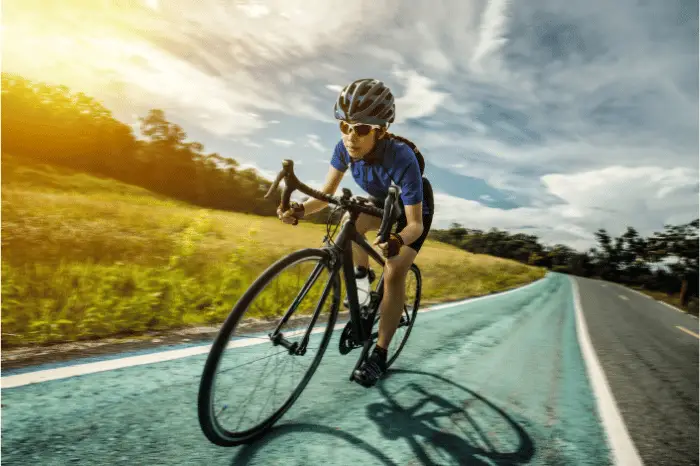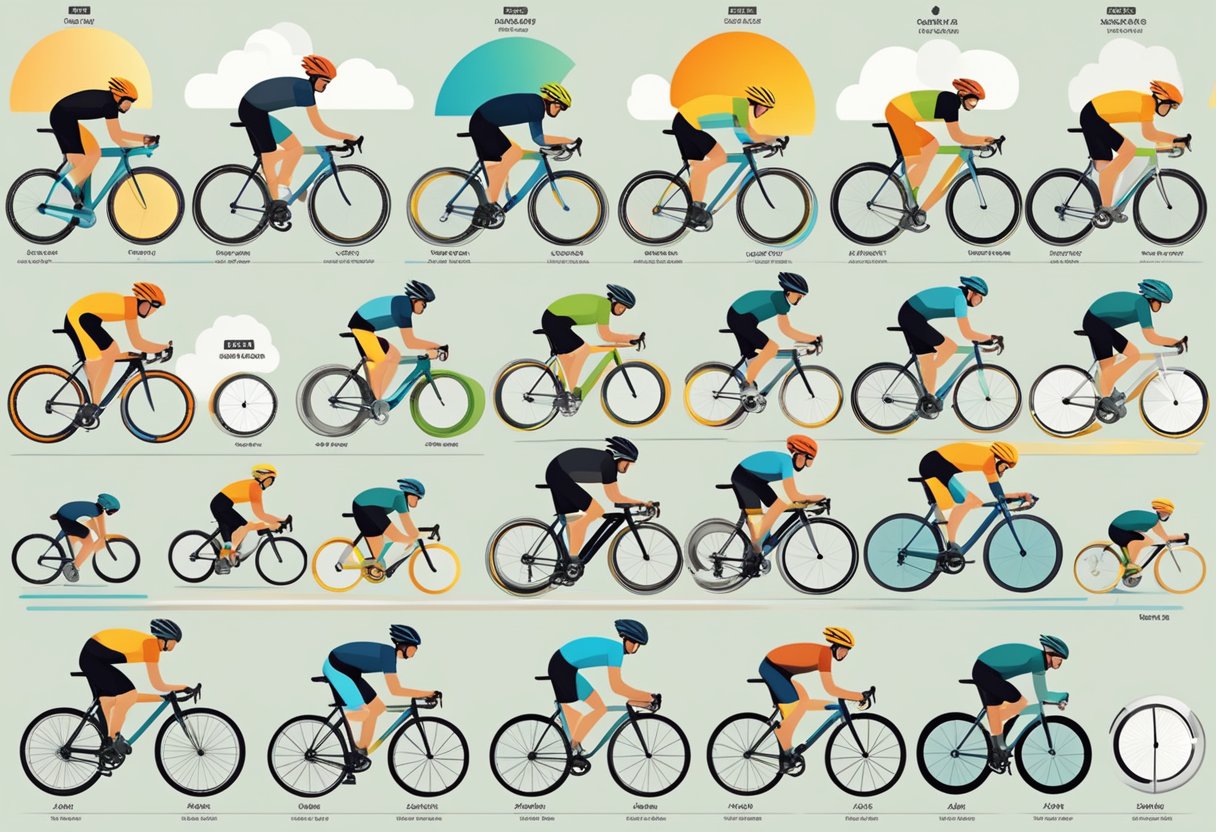
Cycling is a great way to stay fit and healthy, and it’s also an enjoyable way to explore the great outdoors. One of the most important factors that can affect your cycling experience is your speed. Cycling speed is affected by a variety of factors, including terrain, weather conditions, and your fitness level. Understanding the factors that affect your cycling speed can help you improve your performance and enjoy your rides even more.
Many different factors can affect your cycling speed. The terrain is one of the most important, as cycling on hills or rough terrain can slow you down significantly. Weather conditions can also have a big impact, as cycling into a headwind or riding in the rain can be much more difficult than cycling on a calm, sunny day. Your fitness level and experience can also affect your speed, as more experienced cyclists are generally able to ride faster and farther than beginners.
Key Takeaways
- Cycling speed is affected by a variety of factors, including terrain, weather conditions, and your own fitness level.
- Different types of cyclists have different average speeds, with road cyclists generally riding the fastest and hybrid cyclists riding the slowest.
- There are many ways to improve your cycling speed, including training, upgrading your equipment, and optimizing your riding position.
Factors Affecting Cycling Speed
When it comes to cycling, speed is an important factor for many riders. Several factors can affect your cycling speed, including terrain and elevation, weather conditions, cyclist fitness level, and bicycle type and maintenance.
Terrain and Elevation
The terrain and elevation of your cycling route can greatly affect your speed. Uphill climbs will naturally slow you down, while downhill stretches will allow you to pick up speed. Similarly, rough or uneven terrain can make it difficult to maintain a consistent pace. If you’re looking to increase your cycling speed, consider finding a route with more downhill stretches or smooth pavement.
Weather Conditions
Weather conditions can also have a significant impact on your cycling speed. Strong headwinds can slow you down, while tailwinds can provide a helpful boost. Rain, snow, and other inclement weather can also make it more difficult to maintain your speed. If you’re planning a ride, be sure to check the weather forecast and adjust your expectations accordingly.
Cyclist Fitness Level
Your fitness level is another key factor in determining your cycling speed. Beginner riders with minimal training can typically sustain speeds of 10-14 mph (16-22.5 kph), while more experienced riders may be able to maintain speeds of 20 mph (32 kph) or higher. If you’re looking to increase your cycling speed, consider incorporating interval training and other workouts that focus on building endurance and speed.
Bicycle Type and Maintenance
The type and condition of your bicycle can also affect your cycling speed. Road bikes, for example, are designed for speed and efficiency, while mountain bikes are better suited for off-road terrain. Additionally, regular maintenance such as keeping your tires inflated and your chain lubricated can help ensure that your bike is running smoothly and efficiently. If you’re looking to increase your cycling speed, consider investing in a high-quality road bike and keeping it well-maintained.
Average Speeds by Cyclist Type

When it comes to cycling, the average speed varies depending on the type of cyclist. In this section, we will discuss the average speeds for professional, amateur, and commuter cyclists.
Professional Cyclists
Professional cyclists are the fastest of the bunch. They are highly trained and have years of experience under their belt. According to I Love Bicycling, the average speed for a professional cyclist is around 25-28 mph. However, during races, they can reach speeds of up to 40 mph.
Amateur Cyclists
Amateur cyclists are not as fast as professional cyclists, but they still have a decent speed. The average speed for an amateur cyclist is around 15-18 mph. However, this can vary depending on the terrain, weather conditions, and the cyclist’s fitness level. If you are an amateur cyclist, it is essential to start slow and gradually build up your speed to avoid injuries.
Commuter Cyclists
Commuter cyclists are those who use their bikes to commute to work or run errands. According to Discerning Cyclist, the average speed for a commuter cyclist is around 8-12 mph. Commuter cyclists tend to ride heavier bikes, which can slow them down. Additionally, they may have to deal with traffic and stoplights, which can also affect their speed.
In conclusion, the average speed for a cyclist varies depending on the type of cyclist. Professional cyclists are the fastest, followed by amateur cyclists, and then commuter cyclists. However, it is important to remember that these are just averages, and individual speeds can vary depending on various factors.
Improving Cycling Speed
If you’re looking to improve your cycling speed, there are several ways to do so. In this section, we’ll discuss some effective techniques that can help you increase your average cycling speed.
Training Techniques
One of the most effective ways to improve your cycling speed is by incorporating interval training into your routine. This involves alternating periods of high-intensity effort with periods of lower-intensity effort. By doing so, you can improve your cardiovascular fitness and increase your endurance, which can help you maintain a higher speed for longer periods.
Another technique that can be effective is hill training. By incorporating hills into your training rides, you can improve your leg strength and power, which can help you maintain a higher speed on flat terrain.
Equipment Upgrades
Upgrading your equipment can also help you improve your cycling speed. One of the most effective upgrades is to invest in a lighter bike. This can help you accelerate more quickly and maintain a higher speed with less effort.
Another upgrade to consider is a more aerodynamic bike. By reducing wind resistance, you can maintain a higher speed with less effort. Additionally, upgrading to smoother, more efficient tires can also help you maintain a higher speed.
Nutrition and Hydration
Proper nutrition and hydration are crucial for maintaining a high level of performance on the bike. Make sure you’re consuming enough calories to fuel your rides, and consider incorporating foods that are rich in carbohydrates, protein, and healthy fats.
Staying hydrated is also important, especially on longer rides. Make sure you’re drinking enough water and electrolyte-replenishing fluids to stay hydrated and maintain your energy levels.
By incorporating these techniques into your training and making the right upgrades to your equipment, you can improve your cycling speed and take your performance to the next level.
Measuring and Tracking Speed

If you want to improve your cycling performance, measuring and tracking your speed is essential. There are several ways to do this, including using speedometers, GPS devices, mobile apps, and wearables.
Speedometers and GPS Devices
Speedometers and GPS devices are the most traditional ways to measure and track your cycling speed. They are typically mounted on the handlebars of your bike and provide real-time data on your speed, distance, and other metrics.
Some speedometers and GPS devices also come with additional features like heart rate monitors, cadence sensors, and power meters, which can help you track your performance more accurately.
Mobile Apps and Wearables
Mobile apps and wearables are becoming increasingly popular for measuring and tracking cycling speed. There are several apps available for both iOS and Android that use your phone’s GPS to track your speed, distance, and other metrics.
Wearables like fitness trackers and smartwatches also come with built-in GPS and cycling tracking features, allowing you to monitor your performance without having to carry your phone with you.
Some popular mobile apps and wearables for tracking cycling speed include:
- Strava
- MapMyRide
- Garmin Connect
- Fitbit
- Apple Watch
No matter which method you choose, measuring and tracking your cycling speed can help you identify areas for improvement and track your progress over time.
Safety Considerations
Cycling can be a fun and healthy activity, but it is important to prioritize safety while on the road. Here are some safety considerations to keep in mind:
Traffic Laws and Regulations
It is important to follow traffic laws and regulations while cycling. This includes stopping at stop signs and red lights, using hand signals when turning, and riding in the same direction as traffic. Remember that bicycles are considered vehicles and are subject to the same traffic laws as cars and trucks.
Protective Gear and Visibility
Wearing a helmet while cycling is essential for protecting your head in case of an accident. In addition to a helmet, wearing reflective clothing and using lights on your bike can increase your visibility to drivers, especially during low-light conditions. It is also important to keep your bike in good condition, including checking your brakes and tires regularly.
Overall, staying safe while cycling requires a combination of following traffic laws and regulations, wearing protective gear, and being visible to drivers. By prioritizing safety, you can enjoy the many benefits of cycling while minimizing the risk of accidents or injuries.
